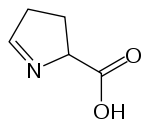In chemistry, an imino acid is any molecule that contains both imine (>C=NH) and carboxyl (-C(=O)-OH) functional groups.[1]
Imino acids are related to amino acids, which contain both amino (-NH2) and carboxyl (-COOH) functional groups, differing in the bonding to the nitrogen.
The D-amino acid oxidase enzymes are able to convert amino acids into imino acids. Also the direct biosynthetic precursor to the amino acid proline is the imino acid (S)-Δ1-pyrroline-5-carboxylate (P5C).
Related terminology
Amino acids containing a secondary amine group (the only proteinogenic amino acid of this type is proline) are sometimes named imino acids,[2][3] though this usage is obsolescent.[1]
The term imino acid is also the obsolete term for imidic acids, containing the -C(=NH)-OH group, and should not be used for them.[1]
References
- ^ a b c IUPAC, Compendium of Chemical Terminology, 2nd ed. (the "Gold Book") (1997). Online corrected version: (2006–) "Imino acids". doi:10.1351/goldbook.I02959
- ^ Proline at the US National Library of Medicine Medical Subject Headings (MeSH)
- ^ "Archived copy". Archived from the original on 2008-01-18. Retrieved 2015-01-03.
External links
- imino+acids at the US National Library of Medicine Medical Subject Headings (MeSH)

-skeletal.svg.png)

